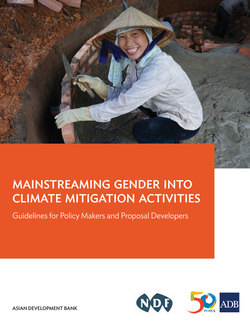Читать книгу Mainstreaming Gender into Climate Mitigation Activities - Eric Zusman - Страница 6
На сайте Литреса книга снята с продажи.
Оглавление| 1 | Introduction: Toward Gender-Responsive Mitigation |
Climate change frequently affects women and men differently (IPCC 2007). The primary reason for these differences is the varying levels of access to resources– knowledge, skills, and finance–that shape how women and men adapt to climate impacts. By the same token, women and men often contribute to activities that mitigate climate change and may share the benefits of climate finance differently. The primary reasons are varying life experiences, consumption patterns, and spending habits. For much of the early history of international climate negotiations, these differences were not readily appreciated. However, the climate policy landscape has undergone important changes in recent years. The impetus for those changes is the realization that actively engaging women as “agents of change” in climate solutions not only helps stabilize the climate but also yields multiple other benefits, including gender equality and women’s empowerment.
Since the 14th Conference of the Parties (COP 14) to the United Nations Framework Convention on Climate Change (UNFCCC), a broad coalition of stakeholders have advocated for more gender-responsive international climate funding mechanisms to help deliver these benefits. In consequence, the recently opened Green Climate Fund (GCF) has committed to a gender-sensitive approach that may influence allocations of future climate financing (UNFCCC 2011). The GCF’s Gender Policy and Action Plan 2014–2017 has provided further evidence of efforts to institutionalize gender’s expanding role in climate financing decisions (GCF 2014). The broader support for cross-sectoral integration in the recently agreed Sustainable Development Goals (SDGs) also suggests that the international development community will look favorably on actions that empower women (SDG 5) while responding to climate change (SDG 13). In short, the above trends reveal an emerging consensus around the promise of gender-responsive climate finance at the international level.
These trends have also not escaped the notice of some policy makers at the national level. For example, several countries have highlighted gender in their pledges of nationally appropriate mitigation actions (NAMAs) to reduce greenhouse gases (GHGs) through 2020 under the UNFCCC (Bock et al. 2015). More recently, an even greater number of countries have included gender in their intended nationally determined contributions (INDCs) that outline their planned response to climate change from 2020 to 2030 (IUCN 2012). The growing signs of national and international support for gender-responsive climate actions are indeed welcome; failures to account for the gender-specific contributions to climate mitigation and adaption have arguably widened equality gaps and narrowed financing bottlenecks (Huyer 2016). At the same time, fully realizing the potential of these international and national reforms will require more guidance on the steps policy makers and other relevant gender stakeholders should follow to develop gender-responsive climate policies and funding proposals. At present, this guidance remains in short supply.
The primary purpose of these guidelines is to fill this need. More concretely, the guidelines aim to equip policy makers, proposal developers, and other interested parties with pragmatic advice on how to mainstream gender into mitigation actions and funding proposals. The guidelines draw heavily on experiences from the Asian Development Bank (ADB) regional technical assistance project entitled Harnessing Climate Change Mitigation Initiatives to Benefit Women. Funded by the Nordic Development Fund, this ADB project aims to assist policy makers in Cambodia, the Lao People’s Democratic Republic, and Viet Nam with integrating gender into national and/or subnational climate strategies, climate action plans, and climate finance screening processes (ADB 2011). The ADB project, like these guidelines, is unique in that it concentrates on the interlinkages between gender and climate mitigation; there has been relatively less attention to the gender–mitigation relationship than that between gender and climate adaptation. Further, while the ADB project focuses on three Southeast Asian countries, this publication is intended for a wide range of countries and stakeholders. The guidelines are, moreover, not meant as a “one size fits all” blueprint; rather, they are intended to serve as flexible “fit for purpose” steps that can be tailored to particular national and local circumstances. They are also intended to outline ways to not only recognize gender co-benefits but also give gender stakeholders an elevated platform and an audible voice at critical junctures of the decision-making process (Huyer et al. 2015).
The guidelines are organized into three complementary sections. The first section outlines the rationale for seeking gender into climate actions and then details a nine-step process for integrating gender into NAMAs and INDCs. The second section outlines how gender can be incorporated into four essential elements of climate finance proposals that may draw support from the GCF (in view of the reforms outlined in the aforementioned Gender Policy and Action Plan 2014–2017) as well as other relevant funding mechanisms (including the Climate Investment Funds [CIFs] and Global Environment Facility [GEF]). A concluding section reflects briefly on applications for the guidelines as well as relationships between the climate planning and funding proposal sections. Please note that the guidelines do not offer a more general review of climate and gender; such a review can be found in many sources, including a previous publication from this project entitled Training Manual to Support Country Driven-Gender and Climate Change (ADB and NDF 2015).
